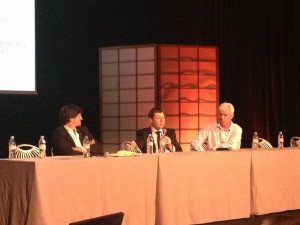SVGE’s Football Production Summit: industry leaders on emerging technologies, ‘storytelling’ function

(Left to right) Mediapro/La Liga’s Ignacio Arrola Albarracin, BSkyB’s Gary Hughes, Sky Sports’ Keith Lane
New techniques continue to emerge, but the focus above all must be on ‘storytelling’ and enhancing the overall viewer experience of match-day action. That was the overriding message of the first panel session at SVG Europe’s Football Production Summit, which drew ‘leader perspectives’ from Sky Sports’ Keith Lane, BSkyB’s Gary Hughes and Mediapro/La Liga’s Ignacio Arrola Albarracin.
Moderator (and IEC in Sport COO and SVG Europe chairman) Peter Angell kicked off proceedings by asking panellists what impact an ever-expanding technical arsenal and number of camera positions were having on production methodologies. “From our point of view, yes, we can have more cameras, but is it technology for technology’s sake?” asked Hughes, rhetorically. “Our perspective is that whatever technology you use, it has to reflect the content and enhance the story. We are working to use the touchscreen and the ChyronHego-driven [Red Bee] Piero system to pull content from the games and really give viewers the extra dimension. The touchscreen technology allows us to educate the viewer and go behind the story.”
Arrola Albarracin agreed that the emphasis has to be on storytelling. “With second screen, viewers are getting the possibility to receive different stories and to share these with friends,” he said. The challenge is to make it easy and trouble-free for the viewer to “receive and interact” with the content.
Sky Sports, noted Lane, is working “very hard in making sure that content is king”. Being “smarter” with its many and varied sports productions has entailed bringing content “into the building in a way we’ve done before, and allowing multiple productions to get access.” Viewer habits might be changing – “kids might be watching their football in the lounge, whilst Dad is watching on Sky Go in the kitchen” – but second screen provides numerous opportunities for “giving a lot more depth to the narrative”.
The impulse to deliver more content in more ways is inarguable – but what about the impact of new formats and systems? “There seems to be agreement that 3D is ‘done’, but 4K is going to be available and [that could be great for] super slow-motion highlights,” said Arrola Albarracin. For his part, Lane highlighted the possibilities afforded by increasingly small form-factor cameras: “We are looking at this technology all the time and seeing how we can improve it. Often it’s down to governing bodies and what they allow.”
With Goal Line Technology seemingly resolving many of the practical problems of the game – “it’s been a massive success and really ended that debate,” said Hughes – broadcasters can maintain their focus on optimising the viewer experience on and off the pitch. Last word to Hughes: “The term we use is ‘getting closer’ [to the action]. I believe we have made great strides – and will continue to do so.”
